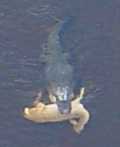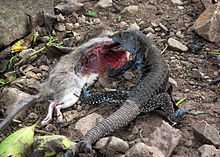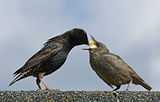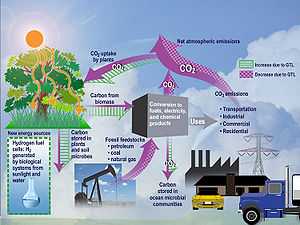Predation
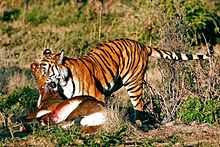

In ecology, predation is a biological interaction where a predator (an organism that is hunting) feeds on its prey (the organism that is attacked).[1] Predators may or may not kill their prey prior to feeding on them, but the act of predation often results in the death of its prey and the eventual absorption of the prey's tissue through consumption.[2] Thus predation is often, though not always, carnivory. Other categories of consumption are herbivory (eating parts of plants), mycophagy (eating parts of fungi) and detritivory, the consumption of dead organic material (detritus). All these consumption categories fall under the rubric of consumer-resource systems.[3] It can often be difficult to separate various types of feeding behaviors.[1] For example, some parasitic species prey on a host organism and then lay their eggs on it for their offspring to feed on it while it continues to live in or on its decaying corpse after it has died. The key characteristic of predation however is the predator's direct impact on the prey population. On the other hand, detritivores simply eat dead organic material arising from the decay of dead individuals and have no direct impact on the "donor" organism(s).
Selective pressures imposed on one another often leads to an evolutionary arms race between prey and predator, resulting in various antipredator adaptations. Ways of classifying predation surveyed here include grouping by trophic level or diet, by specialization, and by the nature of the predator's interaction with prey.
Functional classification
Classification of predators by the extent to which they feed on and interact with their prey is one way ecologists may wish to categorize the different types of predation. Instead of focusing on what they eat, this system classifies predators by the way in which they eat, and the general nature of the interaction between predator and prey species. Two factors are considered here: How close the predator and prey are (in the latter two cases the term prey may be replaced with host) and whether or not the prey are directly killed by the predator is considered, with true predation and parasitoidism involving certain death.
True predation
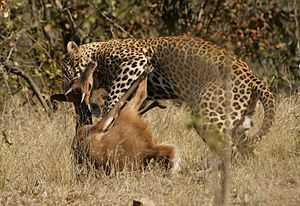
A true predator can commonly be known as one that kills and eats another living thing. Whereas other types of predator all harm their prey in some way, this form kills them. Predators may hunt actively for prey, or sit and wait for prey to approach within striking distance, as in ambush predators. Some predators kill large prey and dismember or chew it prior to eating it, such as a jaguar or a human; others may eat their (usually much smaller) prey whole, as does a bottlenose dolphin swallowing a fish, or a snake, duck or stork swallowing a frog. Some animals that kill both large and small prey for their size (domestic cats and dogs are prime examples) may do either depending upon the circumstances; either would devour a large insect whole but dismember a rabbit. Some predation entails venom that subdues a prey creature before the predator ingests the prey by killing, which the box jellyfish does, or disabling it, found in the behavior of the cone shell. In some cases, the venom, as in rattlesnakes and some spiders, contributes to the digestion of the prey item even before the predator begins eating. In other cases, the prey organism may die in the mouth or digestive system of the predator. Baleen whales, for example, eat millions of microscopic plankton at once, the prey being broken down well after entering the whale. Seed predation and egg predation are other forms of true predation, as seeds and eggs represent potential organisms. Predators of this classification need not eat prey entirely. For example, some predators cannot digest bones, while others can. Some may eat only part of an organism, as in grazing (see below), but still consistently cause its direct death.
Grazing
Grazing organisms may also kill their prey species, but this is seldom the case. While some herbivores like zooplankton live on unicellular phytoplankton and therefore, by the individualized nature of the organism, kill their prey, many only eat a small part of the plant. Grazing livestock may pull some grass out at the roots, but most is simply grazed upon, allowing the plant to regrow once again. Kelp is frequently grazed in subtidal kelp forests, but regrows at the base of the blade continuously to cope with browsing pressure. Animals may also be 'grazed' upon; female mosquitos land on hosts briefly to gain sufficient proteins for the development of their offspring. Starfish may be grazed on, being capable of regenerating lost arms.
Parasitism
Parasites can at times be difficult to distinguish from grazers. Their feeding behavior is similar in many ways, however they are noted for their close association with their host species. While a grazing species such as an elephant may travel many kilometers in a single day, grazing on many plants in the process, parasites form very close associations with their hosts, usually having only one or at most a few in their lifetime. This close living arrangement may be described by the term symbiosis, "living together", but unlike mutualism the association significantly reduces the fitness of the host. Parasitic organisms range from the macroscopic mistletoe, a parasitic plant, to microscopic internal parasites such as cholera. Some species however have more loose associations with their hosts. Lepidoptera (butterfly and moth) larvae may feed parasitically on only a single plant, or they may graze on several nearby plants. It is therefore wise to treat this classification system as a continuum rather than four isolated forms.
Parasitoidism
Parasitoids are organisms living in or on their host and feeding directly upon it, eventually leading to its death. They are much like parasites in their close symbiotic relationship with their host or hosts. Like the previous two classifications parasitoid predators do not kill their hosts instantly. However, unlike parasites, they are very similar to true predators in that the fate of their prey is quite inevitably death. A well-known example of a parasitoids are the ichneumon wasps, solitary insects living a free life as an adult, then laying eggs on or in another species such as a caterpillar. Its larva(e) feed on the growing host causing it little harm at first, but soon devouring the internal organs until finally destroying the nervous system resulting in prey death. By this stage the young wasp(s) are developed sufficiently to move to the next stage in their life cycle. Though limited mainly to the insect order Hymenoptera, Diptera and Coleoptera parasitoids make up as much as 10% of all insect species.[4][5]
Degree of specialization
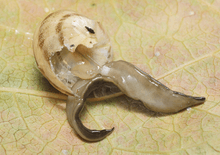
Among predators there is a large degree of specialization. Many predators specialize in hunting only one species of prey. Others are more opportunistic and will kill and eat almost anything (examples: humans, leopards, dogs and alligators). The specialists are usually particularly well suited to capturing their preferred prey. The prey in turn, are often equally suited to escape that predator. This is called an evolutionary arms race and tends to keep the populations of both species in equilibrium. Some predators specialize in certain classes of prey, not just single species. Some will switch to other prey (with varying degrees of success) when the preferred target is extremely scarce, and they may also resort to scavenging or a herbivorous diet if possible.
Trophic level
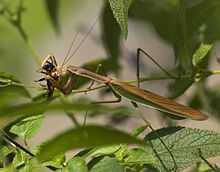
Predators are often another organism's prey, and likewise prey are often predators. Though blue jays prey on insects, they may in turn be prey for cats and snakes, and snakes may be the prey of hawks. One way of classifying predators is by trophic level. Organisms that feed on autotrophs, the producers of the trophic pyramid, are known as herbivores or primary consumers; those that feed on heterotrophs such as animals are known as secondary consumers. Secondary consumers are a type of carnivore, but there are also tertiary consumers eating these carnivores, quartary consumers eating them, and so forth. Because only a fraction of energy is passed on to the next level, this hierarchy of predation must end somewhere, and very seldom goes higher than five or six levels, and may go only as high as three trophic levels (for example, a lion that preys upon large herbivores such as wildebeest, which in turn eat grasses). A predator at the top of any food chain (that is, one that is preyed upon by no organism) is called an apex predator; examples include the orca, sperm whale, anaconda, Komodo dragon, tiger, lion, tiger shark, Nile crocodile, and most eagles and owls—and even omnivorous humans and grizzly bears. An apex predator in one environment may not retain this position as a top predator if introduced to another habitat, such as a dog among alligators, a skunk in the presence of the great horned owl immune to skunk spray, or a snapping turtle among jaguars; a predatory species introduced into an area where it faces no predators, such as a domestic cat or a dog in some insular environments, can become an apex predator by default.
Many organisms (of which humans are prime examples) eat from multiple levels of the food chain and, thus, make this classification problematic. A carnivore may eat both secondary and tertiary consumers, and its prey may itself be difficult to classify for similar reasons. Organisms showing both carnivory and herbivory are known as omnivores. Even herbivores such as the giant panda may supplement their diet with meat. Scavenging of carrion provides a significant part of the diet of some of the most fearsome predators. Carnivorous plants would be very difficult to fit into this classification, producing their own food but also digesting anything that they may trap. Organisms that eat detritivores or parasites would also be difficult to classify by such a scheme.
Predation as competition
An alternative view offered by Richard Dawkins is of predation as a form of competition: the genes of both the predator and prey are competing for the body (or 'survival machine') of the prey organism.[6] This is best understood in the context of the gene centered view of evolution. Another manner in which predation and competition are connected is throughout intraguild predation. Intraguild predators are those that kill and eat other predators of different species at the same trophic level, and thus that are potential competitors.[7]
Ecological role
Predators may increase the biodiversity of communities by preventing a single species from becoming dominant. Such predators are known as keystone species and may have a profound influence on the balance of organisms in a particular ecosystem.[8] Introduction or removal of this predator, or changes in its population density, can have drastic cascading effects on the equilibrium of many other populations in the ecosystem. For example, grazers of a grassland may prevent a single dominant species from taking over.[9]
The elimination of wolves from Yellowstone National Park had profound impacts on the trophic pyramid. Without predation, herbivores began to over-graze many woody browse species, affecting the area's plant populations. In addition, wolves often kept animals from grazing in riparian areas, which protected beavers from having their food sources encroached upon. The removal of wolves had a direct effect on beaver populations, as their habitat became territory for grazing.[10] Furthermore, predation keeps hydrological features such as creeks and streams in normal working order. Increased browsing on willows and conifers along Blacktail Creek due to a lack of predation caused channel incision because they helped slow the water down and hold the soil in place.[10]
Adaptations and behavior
The act of predation can be broken down into a maximum of four stages: Detection of prey, attack, capture and finally consumption.[11] The relationship between predator and prey is one that is typically beneficial to the predator, and detrimental to the prey species. Sometimes, however, predation has indirect benefits to the prey species,[12] though the individuals preyed upon themselves do not benefit.[13] This means that, at each applicable stage, predator and prey species are in an evolutionary arms race to maximize their respective abilities to obtain food or avoid being eaten. This interaction has resulted in a vast array of adaptations in both groups.

One adaptation helping both predators and prey avoid detection is camouflage, a form of crypsis where species have an appearance that helps them blend into the background. Camouflage consists of not only color but also shape and pattern. The background upon which the organism is seen can be both its environment (e.g., the praying mantis to the right resembling dead leaves) or other organisms (e.g., zebras' stripes blend in with each other in a herd, making it difficult for lions to focus on a single target). The more convincing camouflage is, the more likely it is that the organism will go unseen.
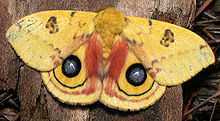
Mimicry is a related phenomenon where an organism has a similar appearance to another species. One such example is the drone fly, which looks a lot like a bee, yet is completely harmless as it cannot sting at all. Another example of batesian mimicry is the io moth, (Automeris io), which has markings on its wings that resemble an owl's eyes. When an insectivorous predator disturbs the moth, it reveals its hind wings, temporarily startling the predator and giving it time to escape. Predators may also use mimicry to lure their prey, however. Female fireflies of the genus Photuris, for example, copy the light signals of other species, thereby attracting male fireflies, which are then captured and eaten (see aggressive mimicry).[14]
Predator

While successful predation results in a gain of energy, hunting invariably involves energetic costs as well. When hunger is not an issue, in general most predators will not seek to attack prey since the costs outweigh the benefits. For instance, a large predatory fish like a shark that is well fed in an aquarium will typically ignore the smaller fish swimming around it (while the prey fish take advantage of the fact that the apex predator is apparently uninterested). Surplus killing represents a deviation from this type of behaviour. The treatment of consumption in terms of cost-benefit analysis is known as optimal foraging theory, and has been quite successful in the study of animal behavior. In general, costs and benefits are considered in energy gain per unit time, though other factors are also important, such as essential nutrients that have no caloric value but are necessary for survival and health.
Social predation offers the possibility of predators to kill creatures larger than those that members of the species could overpower singly. Lions, hyenas, wolves, dholes, African wild dogs, and piranhas can kill large herbivores that single animals of the same species could never dispatch. Social predation allows some animals to organize hunts of creatures that would easily escape a single predator; thus chimpanzees can prey upon colobus monkeys, and Harris's hawks can cut off all possible escapes for a doomed rabbit. Extreme specialization of roles is evident in some hunting that requires co-operation between predators of very different species: humans with the aid of falcons or dogs, or fishing with cormorants. Social predation is often very complex behavior, and not all social creatures (for example, domestic cats) perform it. Even without complex intelligence but instinct alone, some ant species can destroy much larger creatures.
Size-selective predation involves predators preferring prey of a certain size. Large prey may prove troublesome for a predator, while small prey might prove hard to find and in any case provide less of a reward. This has led to a correlation between the size of predators and their prey.[15] Size may also act as a refuge for large prey, for example adult elephants are, in general, safe from predation by lions, but juveniles are vulnerable.[15]
It has been observed that well-fed predator animals in a lax captivity (for instance, pet or farm animals) will usually differentiate between putative prey animals who are familiar co-inhabitants in the same human area from wild ones outside the area. This interaction can range from peaceful coexistence to close companionship; motivation to ignore the predatory instinct may result from mutual advantage or fear of reprisal from human masters who have made clear that harming co-inhabitants will not be tolerated. Pet cats and pet mice, for example, may live together in the same human residence without incident as companions. Pet cats and pet dogs under human mastership often depend on each other for warmth, companionship, and even protection, particularly in rural areas.
Antipredator adaptations
Antipredator adaptations have evolved in prey populations due to the selective pressures of predation over long periods of time.
Aggression
Predatory animals often use their usual methods of attacking prey to inflict or to threaten grievous injury to their own predators. The electric eel uses the same electrical current to kill prey and to defend itself against animals (anacondas, caimans, jaguars, egrets, cougars, giant otters, humans, and dogs) that ordinarily prey upon fish similar to an electric eel in size; the electric eel thus remains an apex predator in a predator-rich environment. A predator small enough to be prey for others, the domestic cat uses its formidable teeth and claws as weapons against animals that might confuse a cat with easier prey. Many non-predatory prey animals, such as a zebra, can give a strong kick that can maim or kill, while others charge with tusks or horns.
Mobbing behavior
Mobbing behavior occurs when members of a species drive away their predator by cooperatively attacking or harassing it. Most frequently seen in birds, mobbing is also seen in other social animals. For example, nesting gull colonies are widely seen to attack intruders, including humans.[11] Costs of mobbing behavior include the risk of engaging with predators, as well as energy expended in the process, but it can aid the survival of members of a species.
While mobbing has evolved independently in many species, it tends to be present only in those whose young are frequently preyed on, especially birds. It may complement cryptic behavior in the offspring themselves, such as camouflage and hiding. Mobbing calls may be made prior to or during engagement in harassment.
Mobbing can be an interspecies activity: it is common for birds to respond to mobbing calls of a different species. Many birds will show up at the sight of mobbing and watch and call, but not participate. It should also be noted that some species can be on both ends of a mobbing attack. Crows are frequently mobbed by smaller songbirds as they prey on eggs and young from these birds' nests, but these same crows will cooperate with smaller birds to drive away hawks or larger mammalian predators. On occasion, birds will mob animals that pose no threat.
Advertising unprofitability

A Thomson's gazelle seeing a predator approach may start to run away, but then slow down and stot. Stotting is jumping into the air with the legs straight and stiff, and the white rear fully visible. Stotting is maladaptive for outrunning predators; evidence suggests that stotting signals an unprofitable chase. For example, cheetahs abandon more hunts when the gazelle stots, and in the event they do give chase, they are far less likely to make a kill.[16]
Aposematism, where organisms are brightly colored as a warning to predators, is the antithesis of camouflage. Some organisms pose a threat to their predators—for example they may be poisonous, or able to harm them physically. Aposematic coloring involves bright, easily recognizable and unique colors and patterns. For example, bright coloration in Variable Checkerspot butterflies leads to decreased predation attempts by avian predators.[17] Upon being harmed (e.g., stung) by their prey, the appearance in such an organism will be remembered as something to avoid. While that particular prey organism may be killed, the coloring benefits the prey species as a whole.
Domestic cats, animals similar in size to such prey species as rabbits, make a hissing sound reminiscent of a snake, advertising that they can put up formidable defenses for their size. Such can deter confrontations harmful to both the cat and to an animal in search of small animals as prey.
Chemical defense
Some organisms have evolved chemical weapons that are effective deterrents against predation. It is most common in insects, but the skunk is a particularly dramatic mammalian example. Other examples include the Bombardier beetle, which can accurately shoot a predator with a stream of boiling poison, the Pacific beetle cockroach, which sprays a quinone mixture from modified spiracles, or the ornate moth, which acquires toxins from its larval food plant that deter most of its predators.[18]
Terrain Fear Factor
The "terrain fear factor" is an idea that assesses the risks associated with predator/prey encounters. This idea suggests that prey will change their usual habits to adjust to the terrain and its effect on the species' predation. For example, a species may forage in a terrain with a lower predation risk as opposed to one with high predation risk.[19]
Population dynamics
It is fairly clear that predators tend to lower the survival and fecundity of their prey, but on a higher level of organization, populations of predator and prey species also interact. It is obvious that predators depend on prey for survival, and this is reflected in predator populations being affected by changes in prey populations. It is not so obvious, however, that predators affect prey populations.[20] Eating a prey organism may simply make room for another if the prey population is approaching its carrying capacity.
The population dynamics of predator-prey interactions can be modelled using the Lotka–Volterra equations. These provide a mathematical model for the cycling of predator and prey populations. Predators tend to select young, weak, and ill individuals.[21]
Evolution of predation
Predation appears to have become a major selection pressure shortly before the Cambrian period—around 550 million years ago—as evidenced by the almost simultaneous development of calcification in animals and algae,[22] and predation-avoiding burrowing. However, predators had been grazing on micro-organisms since at least 1,000 million years ago.[23][23][24][25][26]
Humans and predation
As predators
Humans are omnivorous. They hunt and trap animals using weapons and tools like snares, clubs, spears, fishing gear, firearms to boats, and motor vehicles. Humans even use other predatory species, (such as dogs, cormorants, and falcons) in hunting and fishing; some people even enlist such non-predatory beasts, like horses, camels, and elephants in getting approaches to prey.

Humans have reshaped huge expanses of the world as ranges and farms for the raising of livestock, poultry, and fish to be eaten as meat. However, it can be debated whether or not harvesting livestock fits strictly in the definition of predation.
Human raising and eating of livestock is part of agriculture, and involves the feeding of and caring for animals, followed by their being slaughtered with an appropriate tool, cutting up, and cooking. In many cultures, animals are hunted or farmed by specialists (such as ranchers or fishermen), brought to a marketplace, and sold in pieces to the people who actually consume the meat.
As prey

A lone naked human is at a physical disadvantage to other comparable apex predators in areas such as speed, bone density, weight, and physical strength. Humans also lack innate weaponry such as claws. Without crafted weapons, society, or cleverness, a lone human can easily be defeated by fit predatory animals, such as wild dogs, big cats and bears. There are even recorded instances of lone humans being preyed upon by large carnivores (see Man-eater). However, humans are not solitary creatures; they are social animals with highly developed social behaviors. Furthermore, humans and their ancestors (such as Homo erectus) have been using stone tools and weapons for well over a million years. Anatomically modern humans have been apex predators since they first evolved, and many species of carnivorous megafauna actively avoid interacting with humans; the primary environmental competitor for a human is other humans. The one subspecies of carnivorous megafauna that does interact frequently with humans in predatory roles is the domestic dog, but usually as a partner in predation especially if they hunt together. Cannibalism has occurred in various places, among various cultures, and for various reasons. At least a few people, such as the Donner party, are said to have resorted to it in desperation.
In conservation
Predators are an important consideration in matters relating to conservation. In many cases, the predators not only are apex predators but are also endangered species themselves, as they have lower population sizes than prey species and are much more vulnerable to extinction because of their population size, competition with other predators, and the fluctuations in prey populations.
Having small population size is a characteristic almost universally inherent to apex predators, humans and dogs by far the most blatant exceptions. Low numbers wouldn't be a problem for apex predators if there was an abundance of prey and no competition or niche overlap, a scenario that is rarely, if ever, encountered in the wild. The competitive exclusion principle states that if two species' ecological niches overlap, there is a very high likelihood of competition as both species are in direct competition for the same resources. This factor alone could lead to the extirpation of one or both species, but is compounded by the added factor of prey abundance.
A predator's effect on its prey species is hard to see in the short-term. However, if observed over a longer period of time, it is seen that the population of a predator will correlationally rise and fall with the population of its prey in a cycle similar to the boom and bust cycle of economics. If a predator overhunts its prey, the prey population will lower to numbers that are too scarce for the predators to find. This will cause the predator population to dip, decreasing the predation pressure on the prey population. The decrease in predators will allow the small number of prey left to slowly increase their population to somewhere around their previous abundance, which will allow the predator population to increase in response to the greater availability of resources. If a predator hunts its prey species to numbers too low to sustain the population in the short term, they can cause not only the extinction or extirpation of the prey but also the extinction of their own species, a phenomenon known as coextinction. This is a risk that wildlife conservationists encounter when introducing predators to prey that have not coevolved with the same or similar predators. This possibility depends largely on how well and how fast the prey species is able to adapt to the introduced predator. One way that this risk can be avoided is if the predator finds an alternative prey species or if an alternative prey species is introduced (something that ecologists and environmentalists try to avoid whenever possible). An alternative prey species would help to lift some of the predation pressure from the initial prey species, giving the population a chance to recover, however it does not guarantee that the initial prey species will be able to recover as the initial prey population may have been hunted to below sustainable numbers or to complete extinction.
Biological pest control
Predators may be put to use in conservation efforts to control introduced species. Although the aim in this situation is to remove the introduced species entirely, keeping its abundance down is often the only possibility. Predators from its natural range may be introduced to control populations, though in some cases this has little effect, and may even cause unforeseen problems. Besides their use in conservation biology, predators are also important for controlling pests in agriculture. Natural predators are an environmentally friendly and sustainable way of reducing damage to crops, and are one alternative to the use of chemical agents such as pesticides.
See also
| Wikimedia Commons has media related to Predation. |
- Bird of prey
- Built for the Kill, a major nature series on the habits of predatory animals
- Consumer-resource systems
- Overpopulation in wild animals
- Prey drive
- Wa-Tor
References
- ↑ 1.0 1.1 Begon, M., Townsend, C., Harper, J. (1996). Ecology: Individuals, populations and communities (Third edition). Blackwell Science, London. ISBN 0-86542-845-X, ISBN 0-632-03801-2, ISBN 0-632-04393-8.
- ↑ Encyclopædia Britannica: "predation"
- ↑ Getz, W (2011). "Biomass transformation webs provide a unified approach to consumer–resource modelling". Ecology Letters 14: 113–124. doi:10.1111/j.1461-0248.2010.01566.x. PMC 3032891. PMID 21199247.
- ↑ Godfray, H.C.J. (1994). Parasitoids: Behavioral and Evolutionary Ecology. Princeton University Press, Princeton. ISBN 0-691-03325-0, ISBN 0-691-00047-6. P. 20.
- ↑ Feener, Jr., Donald H.; Brian V. Brown (January 1997). "Diptera as Parasitoids". Annual Review of Entomology 42 (1): 73–97. doi:10.1146/annurev.ento.42.1.73. PMID 15012308. Retrieved 2009-03-04.
- ↑ Dawkins, R. (1976). The Selfish Gene. Oxford University Press. ISBN 0-19-286092-5.
- ↑ Fedriani J. M., Fuller T. K., Sauvajot R. M., York E. C. (2000). "Competition and intraguild predation among three sympatric carnivores". Oecologia 125 (2): 258–270. doi:10.1007/s004420000448. PMID 24595837.
- ↑ Changing the distribution of predators and prey in an ecosystem can turn things upside down. March 1, 2013 Scientific American
- ↑ Botkin, D. and E. Keller (2003). Enrivonmental Science: Earth as a living planet. John Wiley & Sons. ISBN 0-471-38914-5. P.2.
- ↑ 10.0 10.1 William J. Ripple and Robert L. Beschta. "Wolves and the Ecology of Fear: Can Predation Risk Structure Ecosystems?" 2004.
- ↑ 11.0 11.1 Alcock, J. (1998). Animal Behavior: An Evolutionary Approach (6th edition). Sunderland, Mass.: Sinauer Associates, Inc. ISBN 0-87893-009-4.
- ↑ Bondavalli C., Ulanowicz R.E. (1999). "Unexpected effects of predators upon their prey: The case of the American alligator". Ecosystems 2: 49–63. doi:10.1007/s100219900057.
- ↑ Dawkins, R. (2004). The Ancestor's Tale. Boston: Houghton Mifflin. ISBN 0-618-00583-8.
- ↑ Lloyd J.E. (1965). "Aggressive Mimicry in Photuris: Firefly Femmes Fatales". Science 149 (3684): 653–654. doi:10.1126/science.149.3684.653.
- ↑ 15.0 15.1 Molles, Manuel C., Jr. (2002). Ecology: Concepts and Applications (International ed.). New York: The McGraw-Hill Companies, Inc. ISBN 0-07-112252-4.
- ↑ Caro T. M. (1986). "The functions of stotting in Thomson's gazelles: Some tests of the predictions". Animal Behaviour 34 (3): 663–684. doi:10.1016/S0003-3472(86)80052-5.
- ↑ Bowers, M. D., Irene L. Brown, and Darryl Wheye. "Bird Predation as a Selective Agent in a Butterfly Population." Evolution 39.1 (1985): 93-103.
- ↑ Conner, W.E. (2009). Tiger Moths and Woolly Bears—behaviour, ecology, and evolution of the Arctiidae. New York: Oxford University Press. pp. 1–10.
- ↑ Ripple William J., Beschta Robert L. (2004). "Wolves and the ecology of fear: Can predation risk structure ecosystems?". BioScience 54 (8): 755–66. doi:10.1641/0006-3568(2004)054[0755:WATEOF]2.0.CO;2.
- ↑ Horning, M., Mellish, J.E. (2012). "Predation on an Upper Trophic Marine Predator, the Steller Sea Lion: Evaluating High Juvenile Mortality in a Density Dependent Conceptual Framework". PLoS ONE 7 (1): e30173. doi:10.1371/journal.pone.0030173. PMC 3260237. PMID 22272296.
- ↑ Genovart, M; Negre, N; Tavecchia, G; Bistuer, A; Parpal, L; Oro, D (2010). "The young, the weak and the sick: evidence of natural selection by predation". PLOS ONE 5 (3): e9774. doi:10.1371/journal.pone.0009774. PMC 2841644. PMID 20333305.
- ↑ Grant, S. W. F.; Knoll, A. H.; Germs, G. J. B. (1991). "Probable Calcified Metaphytes in the Latest Proterozoic Nama Group, Namibia: Origin, Diagenesis, and Implications". Journal of Paleontology (JSTOR) 65 (1): 1–18. JSTOR 1305691. PMID 11538648.
- ↑ 23.0 23.1 Bengtson, S. (2002). "Origins and early evolution of predation". In Kowalewski, M., and Kelley, P.H. The fossil record of predation. The Paleontological Society Papers 8 (PDF). The Paleontological Society. pp. 289–317. Retrieved 2007-12-01.
- ↑ McNamara, K.J. (20 December 1996). "Dating the Origin of Animals". Science 274 (5295): 1993–1997. Bibcode:1996Sci...274.1993M. doi:10.1126/science.274.5295.1993f. Retrieved 2008-06-28.
- ↑ Awramik, S.M. (19 November 1971). "Precambrian columnar stromatolite diversity: Reflection of metazoan appearance" (ABSTRACT). Science 174 (4011): 825–827. doi:10.1126/science.174.4011.825. PMID 17759393. Retrieved 2007-12-01.
- ↑ Stanley (2008). "Predation defeats competition on the seafloor" (EXTRACT). Paleobiology 34 (1): 1–21. doi:10.1666/07026.1.
Further reading
- Barbosa, P. and I. Castellanos (eds.) (2004). Ecology of predator-prey interactions. New York: Oxford University Press. ISBN 0-19-517120-9.
- Curio, E. (1976). The ethology of predation. Berlin; New York: Springer-Verlag. ISBN 0-387-07720-0.
External links
| Look up predation in Wiktionary, the free dictionary. |
| Look up predate or pre-date in Wiktionary, the free dictionary. |
| Wikiquote has quotations related to: Predation |
- Wolfram Demonstrations Project: Predator-Prey Equations by Eric W. Weisstein
- Predators, three articles by Olivia Judson, NY Times, Sept. & Oct., 2009
| |||||||||||||||||||||||||||||||||||||||
| ||||||||||||||||||||||||||||||||||||||||
| ||||||||||

